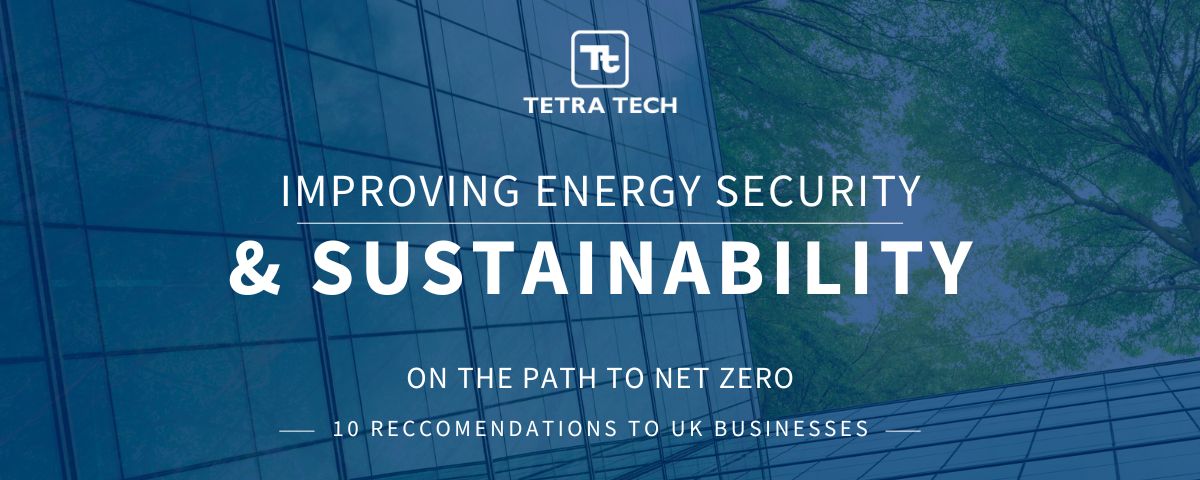
The energy crisis has led to a drive to improve energy security and save costs. These factors added to the need to act on climate change and a desire to drive towards Net Zero are creating challenging times but also opportunity for businesses.
Rukhsana Faiz, Energy & Utilities Director, Tetra Tech has identified 10 actions that could give some for thoughts to businesses looking to tackle energy issues and becoming more sustainable.
To effectively achieve an improved energy performance and higher level of energy security, it can be valuable consider the following by working with suppliers and landlords to create a more effective and holistic energy reduction effort.
- Measure and monitor building energy performance to reduce consumption, improve energy efficiency and reduce energy usage. Some suggestions are to unplug appliances where possible, install LED lighting, add new or more insulation, conduct energy audits and review/ upgrade HVAC systems. A further suggestion would be the implementation of a building management system (BMS) to further control power supply, energy consumption and other factors.
- Purchase electricity under a renewable energy supply contract to eliminate the electricity element from your carbon footprint.
- Enter into an off-site renewable energy PPAs (Power Purchase Agreements). Offsite power purchase agreements are renewable energy contracts between a project developer and a company, where the renewable energy installation is not sited at the location of the company’s electricity usage.
- Generate on-site renewables- e.g. Solar PV either roof or ground mounted. A battery could also be installed alongside to give greater security/ flexibility. You could also investigate demand side response opportunities, where you may receive compensation for being flexible with your energy use and/ or making your surplus capacity available to the grid.
- Use low carbon heating – low carbon heat networks running on biomass boilers, heat pumps (water source, air source, ground source, sewer source, river source, lake source, marine source), geothermal sources and heat recovered from industrial processes. Looking into the future, use hydrogen as an alternative to natural gas, install hydrogen ready boilers, use green hydrogen (which uses renewable electricity for electrolysis to split water into hydrogen and oxygen), and set up a hydrogen hub in your area/ for your industries.
- Diversify the energy mix of hard-to-abate industries such as cement and glass. Wind, solar, hydro and green hydrogen all have roles to play. Replace fossil fuel for heating with renewable electricity e.g. in ethylene production. Replace feedstock or fuel with carbon neutral hydrogen e.g. in ammonia production and cement. Replace feedstock or fuel with sustainably produced biomass to reduce CO2 emissions e.g. use bio-based feedstocks in chemicals production and glass. Capture CO2 emitted and store or use the CO2. Other concepts like “Power-to-X“, which redirects unused renewable grid energy to heavy industries, also show promise.
- Decarbonise transport- fleet electrification/ lower carbon/ hybrid, install EV charging infrastructure in the workplace, hydrogen fueled vans/ trucks, staff engagement – incentivising EVs, cycling, walking, locating offices in central locations that are well serviced by public transport, reducing business travel and using lower carbon forms of travel for business and using innovative business tools to reduce the need for business travel.
- Establish procurement policies requiring supply chain to be net zero companies and support your suppliers in their sustainability journey.
- Reduce waste – use packaging and products that are recyclable or reusable. Solid waste contributes directly to greenhouse gas emissions through the generation of methane from the anaerobic decay of waste in landfills, and the emission of nitrous oxide from solid waste combustion facilities. Both greenhouse gases have high global warming potential: Methane has 21 times the warming potential of carbon dioxide and nitrous oxide has 310 times the warming potential.
- Engage staff and local communities to set us forums for them to engage and, create a fair and just energy transition so everyone can collaboratively make a difference!
Many businesses have set goals to reach Net Zero in the next 5, 10, 20 years but the volatility of the energy markets worldwide is making it hard to map out exactly how they will achieve this. Whilst there are some short and medium term suggestions that could help, we as experts need to keep one eye firmly on the long game and keep Leading with Science® to accelerate solutions which will improve sustainability and energy security.